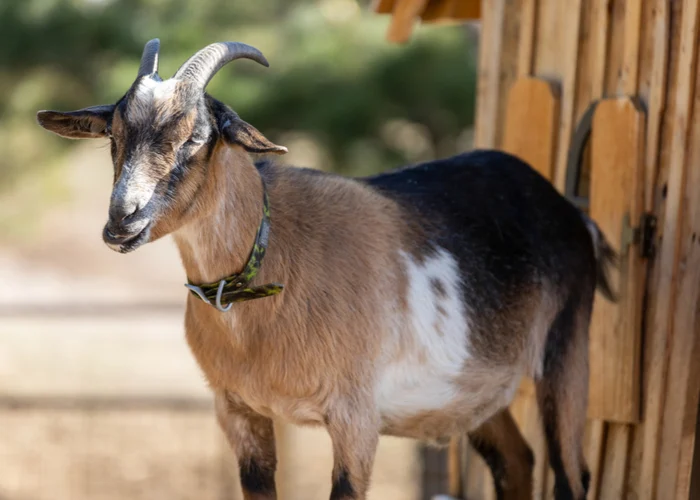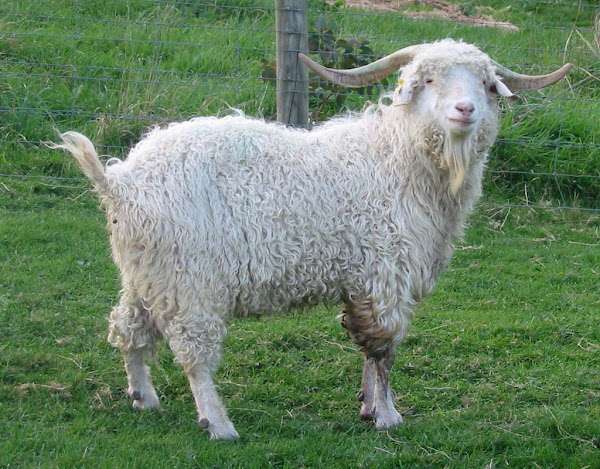
Description:
The Anglo-Nubian is a huge goat with long legs, a facial profile that is noticeably convex, and long pendulous lop ears. The polled or tiny, downward-curving horns-equipped head is borne high. Nannies have a short, silky coat, whereas billies have a longer, slightly rougher coat. White, cream, fawn, chestnut, and black are among the most popular colors, though it can be any of a broad variety of hues, either solid or in different brindled, marbled, or mottled patterns.
Behavior:
These goats are among the friendliest of all goat breeds and will easily make friends with the family. They enjoy interacting with people and will frequently be at your back door begging for your attention, even when kept in big groups. Being highly resilient, they can survive in both hot and cold areas. They are active creatures who thrive in a vast area where they have lots of freedom to wander and feed.
Warning: These goats are notorious for being incredibly boisterous and loud, whether they are pleased, sad, enthusiastic, or afraid. As a result, they are bad dogs in neighborhoods with near neighbors. This is a crucial thing to take into account because you should preferably have more than one goat because the noise can quickly accumulate!
Benefits/Uses:
The Anglo-Nubian goat is bred for both milk production and meat production. Children swiftly put on weight to produce meat. Compared to some Swiss goat breeds, the milk yield is lower, but the milk has a higher fat content. Every day, nannies provide roughly 3.9 kg of milk with an average fat content of 4.8%. The largest recognised annual yield is about 2500 kg, while the highest documented 24-hour yield is over 8.25 kg.
Origin/History:
The traditional native prick-eared British goats and a mixed population of giant lop-eared goats brought from India, the Middle East, and North Africa were crossed to create the Anglo-Nubian breed in the British Isles in the nineteenth century. Several of these were transported to British soil by P & O Steamship Company steamers, which regularly placed goats on board before embarking on a homeward voyage from the Orient, in order to have access to milk and fresh meat during the voyage.
Regardless of their real location or port of origin, some of these goats were frequently off-loaded and sold when the ships anchored in the later nineteenth century.
Examples of the Egyptian Zaraibi, which had a big impact on how the Anglo-Nubian developed, were among them. An Indian Jamnapari imported in 1896, a second Indian goat imported from Chitral, and a Zaraibi imported about the same time all had a significant impact on the breed. Once the initial herd-book entries were made in 1910, foreign breeding stock was never again used.
Early in the 20th century, some were exported to the West Indies; from there, some came to the United States, with the first arrivals being in 1909. Some of them were sent to Brazil. Almost sixty different nations reported on the Anglo-Nubian in 2017 under various names.
Keeping as Pet:

- How to Take Care of Anglo-Nubian Goat?
Nubian goats are quite simple to care for and have the same fundamental needs as other goat breeds. This includes a suitable place to stay, a lot of room to move around, as well as access to wholesome food and clean water.
- Shelter
They will require a simple shelter to sleep in, keep them warm in the winter, sheltered in the summer, and safe from the wind and rain. Should they feel the need for privacy, they can use this area as one. The ideal shelter would be constructed of wood and have lots of ventilation and airflow. It should be adequately insulated for the winter if you reside in a cold climate.
They should be able to sleep in the shelter on soft bedding, such as straw or hay, which needs to be replaced frequently. The shelter should ideally feature a door that you can latch. This can help keep two goats apart if necessary and will keep them secured inside during severe weather or while you’re away.
- Enclosure
Generally speaking, Nubian goats require at least 200 square feet of space per goat, however more space is always preferable. These goats are happiest with plenty of freedom to wander and browse, yet this amount of space is acceptable for brief periods if necessary. Although they are known to eat nearly anything, like other goats, they may be safely permitted to roam, so you might want to plan a place that will keep them out of your flower beds and vegetable garden!
Because Nubians are skilled escape artists, they’ll want a strong sleeping area as well as a high, hard fence. Electric fencing is the greatest technique to contain them to a space, so we advise using it first. These agile animals can climb even sturdy, high fences, therefore the ideal option is a straightforward, portable electric wire driven by a car battery.
Table





